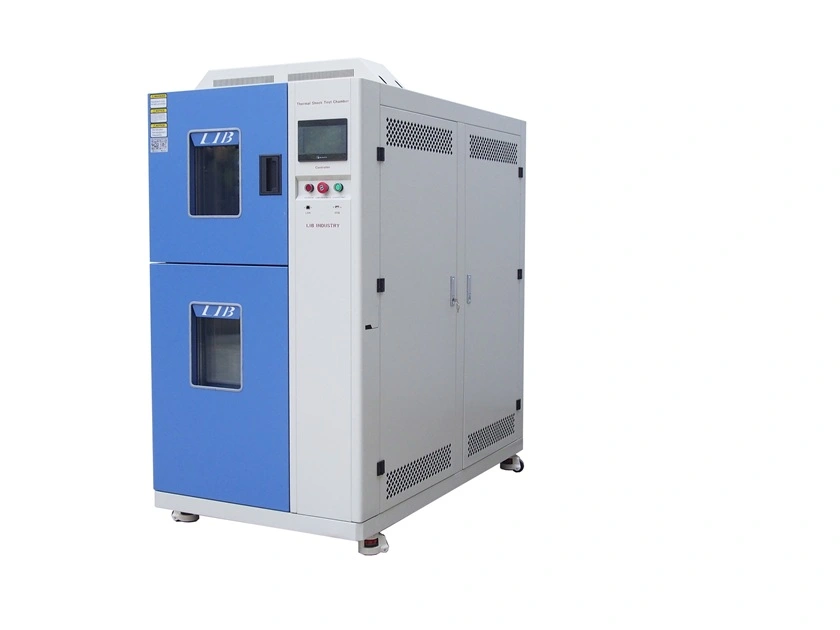Why Stability is Crucial in a Thermal Shock Test Chamber?
Why Stability is Crucial in a Thermal Shock Test Chamber?
Stability forms the foundation for accurate and repeatable results in any thermal shock test chamber. Reliable stability ensures that every test delivers consistent data, which allows engineers to trust their findings and improve product reliability. When a chamber maintains precise conditions, manufacturers can identify weaknesses in materials or components with confidence. LIB places a strong emphasis on stability and precision, helping users achieve dependable outcomes in every test.

Stability in Thermal Shock Test Chambers
What Is Stability?
Stability in a thermal shock test chamber refers to the chamber’s ability to maintain precise and consistent environmental conditions during testing. This means the chamber keeps temperature fluctuations and deviations within strict limits, even as it cycles rapidly between extreme hot and cold zones. Stability ensures that each test cycle exposes products to the same conditions, which is essential for accurate and repeatable results.
The table below outlines key aspects of standardized thermal shock testing:
Aspect | Description / Criteria |
Definition of Thermal Shock | Subjecting PCBs to rapid and extreme temperature changes to simulate harsh environments and identify weaknesses. |
Key Standards | IPC (e.g., IPC-TM-650 2.6.7.1), MIL-STD (e.g., MIL-STD-202 Method 107), JEDEC (e.g., JESD22-A106) |
Testing Methodology | 1. Prepare PCB 2. Expose to low temp chamber 3. Rapid transfer to high temp chamber 4. Hold at high temp 5. Rapid transfer back to low temp 6. Repeat cycles |
Pass/Fail Criteria | 1. No visible damage (cracks, delamination) 2. Electrical functionality within specs 3. No significant resistance/capacitance changes 4. No solder joint failures |
Monitoring Parameters | 1. Chamber temperature and humidity 2. PCB temperature at critical points 3. Electrical parameters (if applicable) |
Post-Test Analysis | 1. Visual inspection 2. Electrical testing 3. Microscopic examination of solder joints/components 4. X-ray or cross-sectional analysis |
Mounting and Fixturing | Use appropriate fixtures to avoid additional stress and ensure uniform heat distribution |
Statistical Analysis | Analyze failure rates, MTBF, and failure trends for large-scale testing |
Why It Matters?
Stability plays a critical role in the effectiveness of a thermal shock test chamber. When a chamber maintains stable conditions, manufacturers can trust the data from each test cycle. This trust allows engineers to identify product weaknesses early and make improvements before products reach the market.
Temperature chambers with high stability create controlled environments that simulate extreme temperature conditions. Their precise control ensures accurate and repeatable testing, which helps manufacturers detect potential failure points. Early detection leads to better product reliability and reduces the risk of costly recalls.
- Thermal shock chambers expose products to rapid temperature cycling between extreme hot and cold zones, simulating real-world environmental stresses.
- This testing checks if products maintain structural integrity and functionality under sudden temperature changes.
- Key parameters such as temperature range, cycle time, and temperature gradient require precise control and stability for valid results.
- Applications include electronics, automotive, aerospace, packaging, and consumer goods.
- Proper calibration, maintenance, and adherence to standards ensure chamber stability, which directly impacts the accuracy and repeatability of tests.
- Thermal shock testing enables manufacturers to detect potential failure points early, allowing design or material adjustments to prevent costly failures.
Stability in a thermal shock test chamber supports industries that demand high reliability, such as automotive, aerospace, and electronics. Consistent test conditions help ensure that products can withstand harsh environments and perform as expected throughout their lifecycle.
Impact on Test Results
Test Accuracy
Test accuracy stands as a critical factor in any laboratory environment. In a thermal shock test chamber, stable temperature control ensures that every test reflects the true performance of the product under examination. When the chamber maintains consistent conditions, engineers can trust that the results show real material behavior, not errors from fluctuating temperatures.
A recent study demonstrated that using a machine learning-based sensor classification method in thermal shock test chambers reduced the standard deviation of temperature readings from 13.55 °C to 5.25 °C. This improvement led to more uniform sensor readings and increased the silhouette score by 0.042. These changes mean the chamber can detect abnormal conditions more reliably and reduce human error. As a result, manufacturers gain more accurate data, which helps them make better decisions about product design and quality.
Key benefits of high test accuracy include:
- Reliable detection of material weaknesses
- Fewer false positives or negatives in test results
- Better compliance with industry standards
Accurate testing helps companies avoid costly recalls and ensures products meet safety and performance requirements.
Repeatability
Repeatability measures how well a test can produce the same results under the same conditions. In thermal shock testing, repeatability proves essential for comparing different batches of products or verifying improvements in design. A stable chamber creates an environment where each test cycle remains consistent, allowing engineers to trust that repeated tests will yield similar outcomes.
Researchers use several benchmarks to evaluate repeatability in thermal testing. The table below summarizes key metrics and their interpretations:
Metric | Description | Interpretation / Benchmark |
Intraclass Correlation Coefficient (ICC) | Measures reliability/agreement between repeated measures. ICC(2,1) used for two-way agreement with single random raters | ICC < 0.5: poor reliability; 0.5-0.75: moderate; 0.75-0.9: good; >0.9: excellent reliability |
Bland-Altman Plot | Visualizes agreement between two measurements by plotting differences against averages | Limits of agreement (95% CI) indicate high agreement if most points fall within these limits |
Concordance Correlation Coefficient (CCC) | Quantifies agreement between repeated measurements | Higher CCC indicates stronger agreement; computed using 'SimplyAgree' package |
Within-Subject Coefficient of Variation (WSCV) | Measures within-subject variability relative to mean | Lower WSCV indicates better repeatability and stability of measurements |
These metrics help engineers confirm that the thermal shock test chamber delivers consistent results. High repeatability means that test data remains trustworthy, even when different operators or test sessions are involved. This reliability supports product development, quality assurance, and compliance with strict industry regulations.
Consistent repeatability builds confidence in test results and supports long-term product reliability.
Factors Affecting Stability
Sealing Mechanisms
Sealing mechanisms play a vital role in maintaining stable conditions during testing. LIB uses double-layer silicone rubber sealing strips on the chamber doors and the sliding basket system. These high-quality silicone seals prevent air leaks and keep temperature fluctuations to a minimum. The chamber’s pneumatic drives compress the seals tightly during transitions between hot and cold zones. This design stops warping and ensures a consistent environment for every test cycle.
Material Durability
Durable materials help the chamber withstand rapid temperature changes and repeated use. LIB constructs the interior with SUS304 stainless steel, known for its strength and resistance to corrosion. The exterior uses a coated steel plate for extra protection. The use of 304-grade stainless steel in low-temperature tanks and galvanized steel in structural parts ensures long-term durability. These materials meet strict industry standards and resist thermal stress, supporting stable performance over time.
Insulation Role
Advanced insulation keeps the chamber’s internal temperature steady. LIB chambers use rigid polyurethane foam and glass fiber as insulation materials. These layers reduce heat loss and block outside temperature changes from affecting the test area. Effective insulation helps maintain temperature fluctuations within ±0.5°C and deviations within ±3°C. This stability allows for accurate and repeatable results, even during rapid cycling.
Control Systems
Control systems manage the heating and cooling cycles with precision. LIB equips its chambers with a programmable color LCD touch screen controller and a French TECUMSEH compressor. The controller uses PLC programming to set and monitor temperature profiles. Solid-state relays and non-contact pulse width adjustment ensure smooth operation. Air circulation fans and ducts distribute temperature evenly, supporting rapid changeover and stable maintenance.
The table below summarizes key performance metrics that validate the effectiveness of these features:
Performance Metric / Feature | Description / Value |
Temperature Deviation | ±2.0°C (constant, no load) |
Temperature Fluctuation | ≤±0.5°C |
Temperature Changeover Time | 3 to 5 minutes |
Sealing Device | Double-layer silicone rubber sealing strips |
Structural Materials | SUS304 stainless steel (2.0mm), galvanized steel |
Insulation Materials | Rigid polyurethane foam, glass fiber |
Control System | Programmable controller, SSR solid-state relay, TECUMSEH compressor |
Durability Indications | Compliance with GB/T and GJB standards, corrosion resistance, thermal stress resistance |
These features work together to ensure that LIB chambers deliver stable, reliable, and repeatable test results.
LIB Thermal Shock Test Chamber Advantages
Precision Control
LIB delivers unmatched precision in temperature management. The chamber operates across a wide range, from -70°C to +150°C, supporting diverse testing needs. Advanced airflow technology ensures uniform temperature distribution, which reduces measurement uncertainty. The programmable color LCD touch screen controller allows users to set exact temperature parameters and monitor real-time data. PT 100 Class A sensors provide accurate readings, while the French TECUMSEH compressor maintains stable cooling and heating rates. These features enable engineers to simulate extreme conditions and achieve reliable results.
Feature | Specification/Detail |
Temperature Range | -70°C to +150°C |
Temperature Fluctuation | ±0.5°C |
Temperature Deviation | ±2.0°C |
Sensors Used | PT 100 Class A |
Cooling Rate | 1°C per minute |
Heating Rate | 3°C per minute |
Control System | Programmable LCD touch screen |
Air Circulation System | Multiple centrifugal fans |
Cooling System | TECUMSEH compressor |
Interior Material | SUS304 stainless steel |
Safety Features
LIB prioritizes safety in every thermal shock test chamber. The chamber includes protections against over-temperature, over-current, refrigerant high-pressure, water shortage, and earth leakage. These safeguards help prevent accidents and equipment damage. The chamber’s construction uses SUS304 stainless steel, which resists corrosion and supports long-term reliability. Industry standards guide the design, ensuring compliance and third-party validation. Safety features support consistent operation and protect both users and test samples.
- Over-temperature and over-current protection
- Refrigerant high-pressure and water shortage safeguards
- Earth leakage detection
- Durable stainless steel interior
Efficiency
LIB chambers stand out for energy efficiency and rapid cycling. The mechanical compression refrigeration system uses advanced technology to reduce energy consumption. The chamber achieves quick temperature transitions, with a changeover time of just 3 to 5 minutes. Efficient insulation and airflow systems minimize heat loss, supporting stable operation and lower running costs. These advantages help manufacturers save resources while maintaining high testing standards.
LIB’s user-friendly interface, robust safety protections, and compliance with industry standards make it a trusted choice for demanding environments.
Stability ensures that test results remain reliable and consistent. LIB chambers use advanced features to keep conditions steady during every test. Engineers trust these results to improve product quality. Choosing equipment with proven stability features protects investments and supports long-term success.
- Consider stability as a top priority when selecting testing equipment.
- Reliable chambers help companies meet industry standards and deliver safe products.
FAQ
What is the main purpose of a thermal shock test chamber?
A thermal shock test chamber helps engineers test how products react to sudden temperature changes. This process finds weak spots in materials or components. Companies use these results to improve product quality and reliability.
How does LIB ensure temperature stability during tests?
LIB uses double-layer silicone rubber seals, advanced insulation, and a programmable controller. The French TECUMSEH compressor keeps temperatures steady. These features work together to maintain precise conditions throughout every test cycle.
Why is repeatability important in thermal shock testing?
Repeatability allows engineers to trust that each test gives similar results. This consistency helps companies compare products, verify improvements, and meet industry standards. Reliable repeatability supports better product development and quality control.
What safety features do LIB chambers include?
LIB chambers offer over-temperature, over-current, and high-pressure protection. The system also detects earth leakage and water shortages. These safety features protect users, test samples, and equipment during operation.
If you would like more information on LIB Industry thermal shock test chambers, please contact us at ellen@lib-industry.com.



